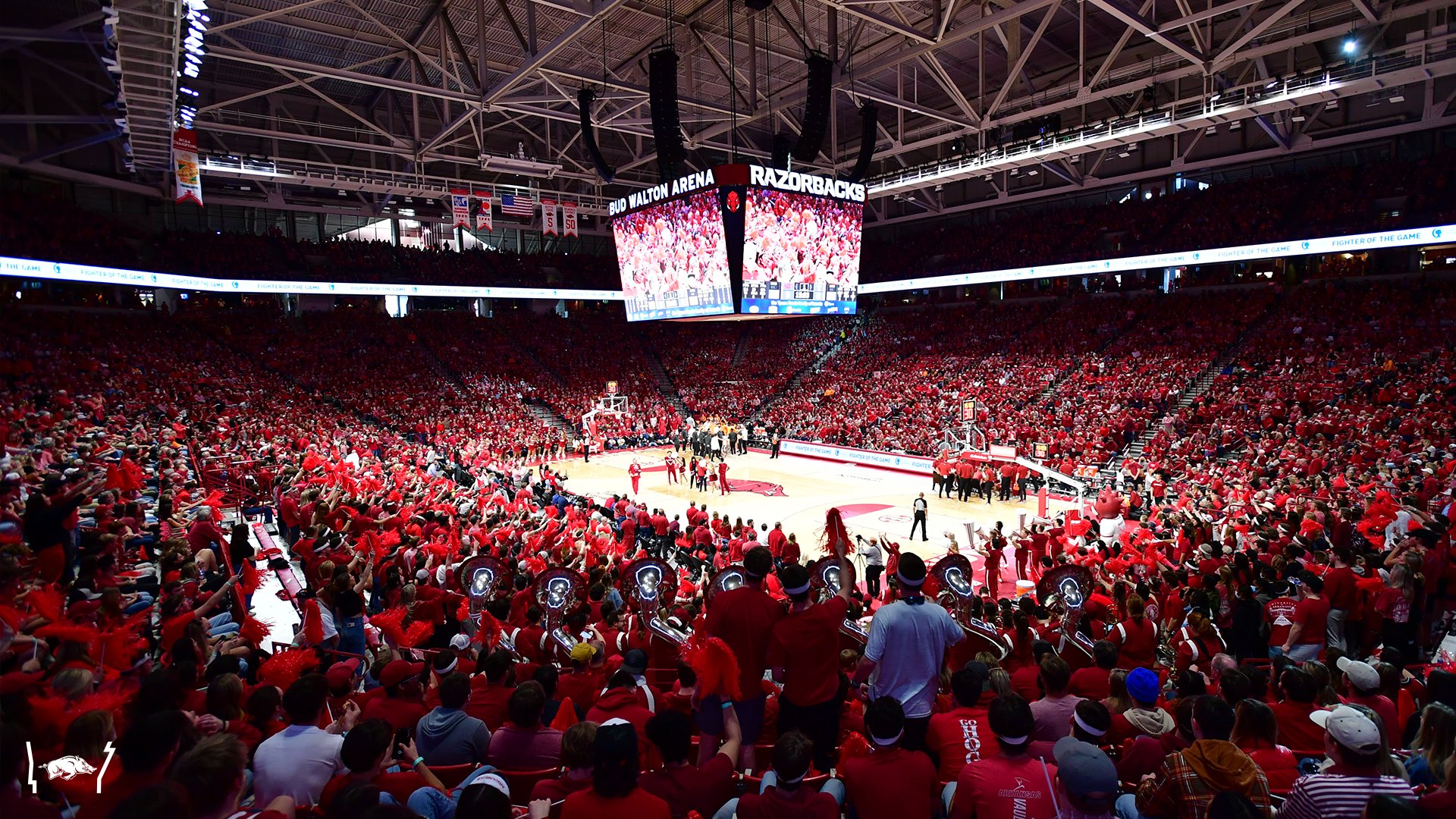Welcome to the Sweet Sixteen! (Arkansas fans only: sorry, Auburn, Tennessee, and Kentucky.)
Feel free to criticize the Hogs all you want for squeaking past 12- and 13-seeds to reach the Sweet Sixteen, but wins are wins. And if the Hogs make the Elite Eight for the second straight year, they will have earned it, because that means they went through top seed Gonzaga.
You may not like Memphis or Penny Hardaway, but they’ve been good to the Hogs this year, and they were almost great. The Tigers’ two wins over Houston this year almost certainly dropped the Cougars out of the last 4-seed spot that went to Arkansas. Then Memphis took Gonzaga down the wire in the second round before falling, 82-78. We need a series with Memphis to show our appreciation, or something.
Meet the Bulldogs
Confused? Check out the advanced stats glossary to learn more about the stats cited here.
Gonzaga has been a mainstay in March for 20 years, but only recently became a true powerhouse. Mark Few started as a GA at Gonzaga in 1989, became the head coach in 1999, and here he is. Gonzaga is the only school he’s coached at. He’s in his 23rd season, he’s made the NCAA Tournament in every single season it’s been held (dang COVID), and his Zags haven’t lost in the first round since 2008 or during the first weekend since 2014. We talk about Gonzaga a lot, but I’m not sure we talk about this enough. It’s truly incredible.
After years of dragging the mid-major West Coast Conference behind them, the Zags finally got some strength of schedule help this year. Saint Mary’s — long Gonzaga’s biggest competitor — earned its best seed ever this year (5), while San Francisco broke through and earned a 10-seed before its coach was hired by Florida. Couple a stronger conference with a big-time non-conference slate — the Zags played Texas, UCLA, Duke, Texas Tech, and Alabama — and Gonzaga’s strength of schedule isn’t far behind Arkansas’, as you’ll see below.
So the Zags aren’t a paper tiger. They’re not invincible, but don’t attribute the hype to them being a small school from a small conference. After all, the WCC and the SEC have the same number of teams in the Sweet Sixteen.
Team Profile

We’ve added some fun metrics to give you a better picture of each team’s profile. Strength of Schedule is the average Adjusted Scoring Margin of all of your opponents. Consistency is the standard deviation of each game’s Adjusted Scoring Margins, and Momentum is a ratio that compares your team’s average ASM over the last 10 games to the all-season ASM.
So Gonzaga’s SOS is fine, and they are pretty consistent, but they actually aren’t playing their best basketball right now. Let’s look at that in chart form:
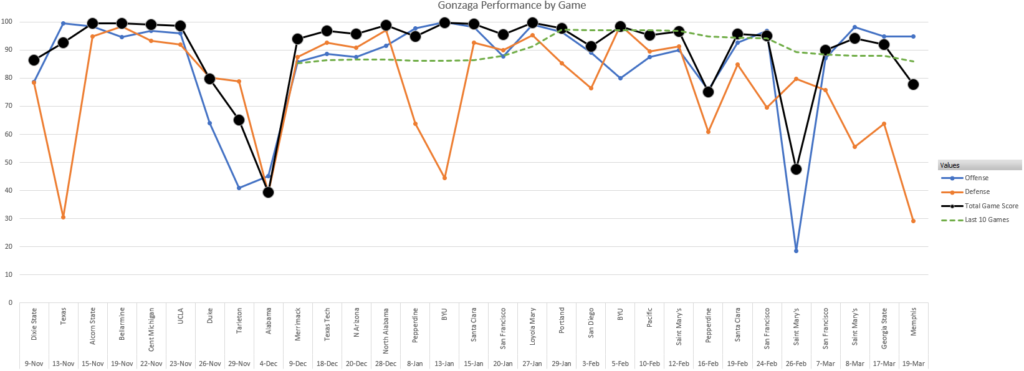
After that loss to Alabama, they played almost perfect basketball for two and a half months until Saint Mary’s roughed up their offense in a 67-57 loss on February 26th (yes, we will be double-clicking on that one). Since mid-February their defense has looked a bit more vulnerable, with Memphis’ athleticism giving them some problems on the second round.
Personnel Profile

Gonzaga’s starting lineup: 6’3, 6’5, 6’7, 6’10, 7’0. Oh boy. Arkansas struggles with size and prefers guard-oriented teams, and Gonzaga is decidedly not guard-oriented. The Zags’ combo of Chet Holmgren and Drew Timme is very similar to Auburn’s combo of Walker Kessler and Jabari Smith… except that Gonzaga has much better guards than Auburn.
The Hogs rank 350th at defending opposing power forwards and 338th at defending opposing centers. Gonzaga is #1 in the nation at total production from the center position, with all of it being from Holmgren. The Zags are also #1 at total production from the small forward position, though the Hogs are respectable 97th at defending them.
The Zags are 8th in the nation in total productivity at shooting guard… but the Hogs have the 3rd-best defense in the nation against shooting guards, with New Mexico State’s Teddy Allen as the latest victim. This is what we mean when we say that Arkansas prefers guard-oriented teams.
Expected lineups
I’m not even sure who Au’Diese Toney will defend. At 6’10, Timme is probably too tall, but there’s zero doubt that Timme is the most important player on Gonzaga. Memphis held him to four points in the first half and led by 10, but then he scored 21 in the second half. The Hogs probably can’t use the four-guard looks where Devo Davis replaces Trey Wade, as that would be ceding way too much height to Gonzaga.
Or would it be? Against Auburn, the Hogs played their preferred Notae-Davis-Toney-Umude-Williams lineup for nearly 21 minutes, outscoring Auburn by 12 points during that time. The Hogs allowed an EPR of 120 while that unit was on the floor (120 shot chances per 100 possessions, basically a ton of offensive rebounds), but defended shooters really well to make up for it. Of course, Auburn’s main backcourt of Wendell Green and KD Johnson are 5’11 and 6’0, while Gonzaga’s combo of Nembhard and Bolton are 6’5 and 6’3, so there’s a big difference there.
You could make a play for putting Jaylin Williams and Kamani Johnson on the floor at the same time if Wade isn’t productive enough. And yes, I’ve seen Connor Vanover mentioned. It’s not the craziest idea ever: as we’ll discuss, Gonzaga’s brand of West Coast basketball is a bit closer to what Vanover can play in when compared to the rockfight that is SEC basketball, but it’s also important to remember that not all 7-footers are made equal, and Vanover is not in Holmgren’s league in terms of body control and all-around talent. Vanover is almost certainly playing the role of Holmgren in practice, but I’d be surprised if he saw the floor.
When Gonzaga has the ball

Yes, the Zags can score. Forget the weak teams they’ve played: Gonzaga scored 86 against Texas, 83 against UCLA, 81 against Duke, 69 against Texas Tech, and 82 against Memphis.
One problem with the “just play Vanover” idea is that Gonzaga doesn’t play slow. They play fast. Like, the fastest:

They are fast by philosophy. Their entire offensive approach is built around getting the defense out of position and attacking those weaknesses. More deliberate offenses may only want to attack when they create the exact opening they want, but the Zags will confidently attack any weakness. These often occur in transition:
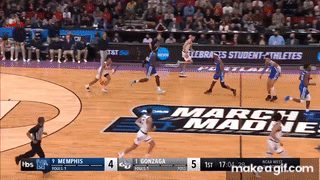
The Zags are in transition on nearly one-third of their possessions and convert 65% of them into points. This is how they crush less-athletic teams. They’ve hit a transition rate of at least 20% in every game this season. Their season-low was 21% in that loss to Saint Mary’s, but their second-lowest was the game came when they scored 86 against Texas.
They don’t require numbers to push if they think the defense is in bad guarding position:
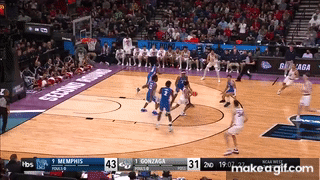
Even when they slow down, they play fast, ranking 1st in Halfcourt APL. Their average non-transition possession lasts just 16.6 seconds. This is normally because they find a shot they are happy with very early in the possession.
Gonzaga’s continuity offense
In the halfcourt, the Zags run a pick-and-roll continuity offense. All that means is that their offense is built around a series of sequences that usually start with a pick-and-roll and continue to repeat on both sides of the floor until they get the defense out of position and attack. Ball movement and spacing are key, but they will occupy the post much more than Vermont or New Mexico State did. All five guys might touch the ball, but Timme and Holmgren basically only get scoring touches on post-ups and basket cuts. If they get the ball on the perimeter, odds are they are just looking to pass to continue the sequence.
Here’s an example of a starting sequence. The Zags will repeat some variation of this, alternating sides of the floor, until they can break the defense down:
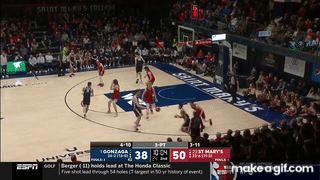
You can see the pick-and-roll by Timme, but watch how the other three players space on the perimeter to prepare quick movement after the ball is passed into the far corner.
Gonzaga will use Timme as a true post player. Not only can he play with his back to the basket like an old-school post-up man, but the Zags love the inside-outside game, with Timme taking advantage of a perimeter defender trying to come help:
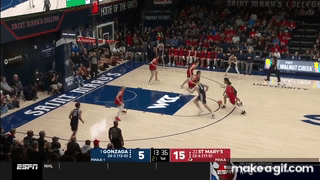
It’s not unusual for the Zags to get Timme an early paint touch and have him take the shot:
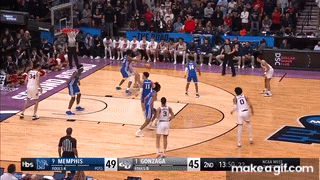
Timme is really good, but he’s definitely more of a finesse player. Notice how he gains almost no ground on his man and ends up taking a shot that really isn’t high-percentage. Good post defenders have been able to body him up:
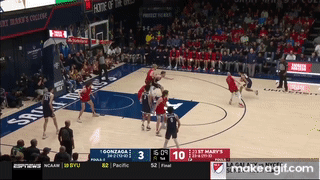
Okay, now let’s look at the halfcourt numbers:

The Zags are 4th in the nation in halfcourt efficiency, but there are some cracks here. Gonzaga has two issues: they are not great at creating shots, and their shot selection isn’t amazing (as hinted by the shot Timme made). You can see this in the three red boxes on their side of the chart above.
Let’s start with shot creation. This is where Gonzaga is similar to Vermont and New Mexico State. They generate just 91.8 shot chances per 100 halfcourt possessions, which ranks 178th nationally. They are pretty good at avoiding turnovers, but they aren’t a great offensive rebounding team. They convert 9% of their missed shots into putbacks (6th nationally, see above chart), but putbacks aren’t included in halfcourt offense stats. They don’t get many of the longer offensive rebounds that lead to a reset of the possession, and that’s what being measured here. Because they are above-average at getting to the line, they take just 71.8 field goals per 100 halfcourt possessions, which ranks 282nd nationally. So they may shoot well, but they might not shoot enough.
And they probably will shoot well: the Zags rank 1st in True Shooting and in Effective Field Goal % (remember: True Shooting includes free throws and EFG is only field goals). They are 25th in 3-point shooting, 6th in midrange shooting, and 2nd in shooting at the rim.
The weakness in the shooting is in the shot selection. Arkansas’ 3-point defense is bad (301st), but the Zags don’t launch a ton of 3-pointers (265th), preferring instead to take midrange jumpers, which account for 29% of their shots this year. Midrange jumpers like the two you see from Timme above are, obviously, least-efficient shot out there. The Zags get 0.86 points per midrange attempt, compared to 1.28 at the rim and 1.12 from beyond the arc. The Hogs have been very good at denying shots at the rim (60th) and at defending midrange jumpers (25th), so the Hogs actually have a decent chance to force Gonzaga into bad shot selection here.
Saint Mary’s 67, Gonzaga 57
So how did Saint Mary’s shut Gonzaga’s top-ranked offense down? Remember, these teams played three times, with Gonzaga scoring 74 and 82 in the two matchups, so it wasn’t a simple case of a bad matchup. Saint Mary’s is good, but let’s look at what they were able to do in this one game:
- They didn’t let the Zags run. Gonzaga’s 21% in transition percentage was its season low. Preventing transition possessions is all about not turning it over outside the perimeter and showing the willingness to get back after a live-ball change of possession. This was clearly part of a strategy: the Gaels are about as good as Arkansas at preventing transitions overall, but they held Gonzaga to 21%, 24%, and 27% in their three matchups.
- They didn’t foul. This will be hard for the Hogs to replicate, but Gonzaga’s 15.5 FTAR was its season low. The Saint Mary’s defense is 19th nationally at this anyway.
- They locked down the perimeter. This one is less about percentage and more about volume. The Zags don’t take a ton of 3’s anyway, but the Gaels were able to chase their shooters off the arc in all three games. Gonzaga actually shot 50% EFG from downtown, but were forced to take less-efficient shots all game.
- They defended well at the rim. This is the big one. Gonzaga took a ton of shots at the rim against Saint Mary’s, but hit just 29% of them. That’s their worst of the season by a huge margin.
What Saint Mary’s didn’t do: prevent putbacks (Gonzaga’s 8% putback conversion % was roughly in line with its season average), slow the Zags down in halfcourt (Gonzaga’s 16.1 seconds per halfcourt possession was faster than its average), prevent shots from going up (72.4 FGAR was above average), prevent midrange jumpers (Zags got 22.4 midrange points per 100 halfcourt possessions and hit them at a solid 46% clip… they just shot too many of them).
The Hogs can actually do most of those things. They can chase shooters off the perimeter, force opponents to take midrange shots instead of 3-pointers, and they defend midrange shots well.
To deal with Gonzaga’s size, the Gaels didn’t match up 1-5, choosing instead to have 6’8 forward Kyle Bowen follow Holmgren around while 6’10 center Matthias Tass dealt with Timme. Tass didn’t give up any height to Timme, while Bowen was giving up about four inches. Here, in the same gif from above, Tass bodies up Timme in the post while the Gaels have no issues boxing Holmgren out at the rim:

I would imagine this is how Arkansas will approach it. Timme isn’t a 3-point threat, so Williams doesn’t have to worry about getting burned with drop coverage if he matches up with him. Williams isn’t an elite defender, but he’s good enough to not get burned at the rim. Then the Hogs need a designated anti-Chet guy. Wade might be too small, so that leaves Kamani Johnson. In addition to giving you two inches, Johnson gives you incredible physicality around the rim. I’m not sure Chet Holmgren — who is just 185 pounds — has faced anyone who will body him up quite like the Hogs will.
To prevent transition runs, the Gaels focused on getting back: their guards had zero offensive rebounds. When Gonzaga tried to run anyway, Saint Mary’s wasn’t afraid was to step in and take charges:
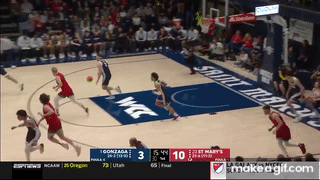
This is obviously a block, not a charge, but hey, you’ve got to crack a few eggs to make an omelet.
When Arkansas has the ball

As we saw above, Gonzaga’s defense has slipped in recent games. In raw numbers (the ones you see here are adjusted for opponent), the Zags’ season average defensive efficiency is 88.1, but their last eight opponents have exceeded that. Memphis’ 113.0 efficiency was the highest allowed by Gonzaga all year.

Transition defense is one place where Gonzaga has slipped. Their first 24 opponents had a Transition Scoring Rate of 19.2, but the last seven are sitting at 25.1 transition points per 100 possessions. Memphis had the second-highest transition rate (36.2) and the highest putback rate (14.5) allowed by Gonzaga this year. They achieved by being aggressive and physical, first in transition:
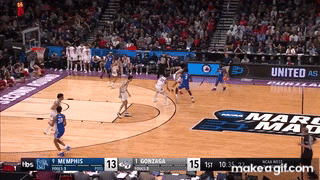
And also under the rim, on putback chances:

Memphis turned 12.5% of its missed shots into putbacks.

Gonzaga’s defense is a mirror image of its offense in terms of halfcourt numbers. The Zags allow too many shots (78.0 per 100 halfcourt possessions, with a 92.2 EPR). They are good at clearing defensive rebounds, but just like Vermont and NMSU, they don’t force many turnovers, which means their opponents get at least one shot chance on way too many possessions.
Vermont and New Mexico State were great at not fouling until they played Arkansas, and the Hogs bullied their way to the line in both games. They’ll have to do it again, as Gonzaga doesn’t give up a ton of free throws.
The Zags are #1 in the country in True Shooting and EFG defense, just like on offense. But just like offense, the percentages are great, but the shot selection isn’t. The Zags allow way too many shots at the rim (32%, 198th) even though they are elite at preventing makes (42%, 4th), largely because of their shot-blocking.
Memphis attacked early and often at the rim. So did Saint Mary’s, who went right after Holmgren from the opening tip:
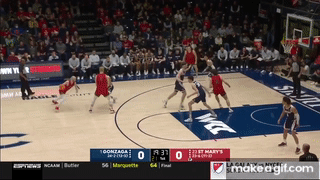
The Gaels even got Holmgren to switch onto 6’2 guard Tommy Kuhse and attacked in isolation:
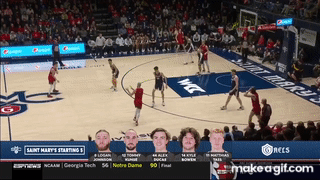
It took 32 minutes, but the Gaels did manage to foul Holmgren out with six points and six rebounds.
Arkansas did this with Notae against Kessler, and I expect that will be in the plan for Holmgren.
Keys to the Game
#1 Be physical and be aggressive.
This is not a game where you can match the opponent’s style and hope to have a prayer. This has to be a rockfight. It has to be the ugliest game of the NCAA Tournament. The Hogs need to move fast on offense, attacking in transition and going after the rim to generate free throws and putbacks. On defense, the Hogs need to attack ball screens and make everything under the rim difficult.
#2 Contain Timme in the post.
The Hogs have not done particularly well against post players this season, but Drew Timme is different from many others, in ways both good and bad. He is key to everything Gonzaga does, so the Hogs have to find a way to keep him from taking over.
#3 The best Notae has to show up.
The Zags aren’t vulnerable against much, but good, aggressive guard play is key to the attack. Arkansas needs the best version of JD Notae on Thursday. He’s been at his best in the biggest games, scoring 28 against Auburn and 30 against Kentucky. Maybe its just a coincidence, but he does seem to play better against forward-oriented teams: his five best games are against Auburn, Mercer, Gardner-Webb, Kentucky, and LSU. All of them except Gardner-Webb have a forward or center as their best player in terms of BPM.
The latest from Fayette Villains, straight to your inbox
Enter your email to subscribe and receive new post alerts and other updates. You can unsubscribe at any time.
